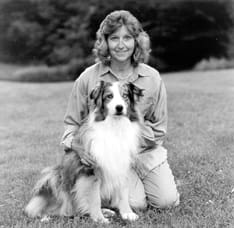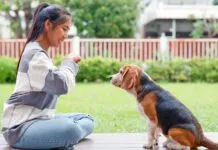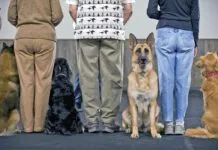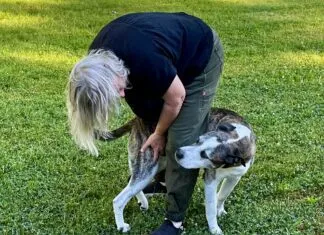While many trainers can readily observe signs of a dysfunctional relationship between dogs and their owners, not all feel comfortable addressing those issues with their students. Vermont-based trainer April Frost has made human/dog relationships something of a specialty. She teaches people how to get to the root of training troubles through the cultivation of a better relationship with their dogs. Once communication problems are cleared up, she finds, dogs readily comply with their handlers wishes.
Frost has 35 years of experience as a dog handler and trainer although she eschews the latter appellation in favor of animal communication facilitator. In her book, Beyond Obedience: Training With Awareness For You and Your Dog, she explains that teaching dogs to have good manners is just a small part of the human/dog relationship. According to Frost, learning, communication, and the cultivation of awareness and mutual respect between you and your dog will always be an ongoing process. Taking the time and energy to build a quality relationship, she says, has numerous and invaluable rewards, including and far surpassing the desired level of obedience.
Benefits of building

We gain tremendous emotional rewards when we improve our relationship with our dogs. Dogs let us experience a deep unconditional love. Many adult humans are aware of this, of course, but Frost believes that this gift has extraordinary value to children. “The relationship children create with dogs is a special one that helps them deal with peer pressure. It is a safe harbor for them to come back to. Their dogs love and accept them, and are non-judgmental,” says Frost. This unconditional acceptance that dogs extend to us is one of the nicest perks that this special relationship offers us.
Another benefit we gain from our dogs is a sense of expansiveness and ease. People tend to be more open around animals, and dogs in particular. Frost notes, We are often more open, tolerant, and kind to our dogs than we are to other people. Have you ever noticed what happens in a work situation when a dog comes for a visit? Suddenly everyone smiles and becomes more relaxed.
If we allow ourselves to open up to their reality and understand what they have to teach us, we gain a fullness and an expanded sense of self, says Frost. A wonderful example of this occurred when Frost’s dog Jessie lost most of her sight due to her advanced age. Jessie had always been Frost’s protector, and now the roles were reversed. When Frost and Jessie were out together she had to pay attention to Jessie’s world and the obstacles that might impact her. Frost became very aware of the cracks and bumps in the street that she needed to maneuver Jessie around. One day in front of a busy hotel Frost looked down and noticed a beautiful, delicate flower growing in the crack of the sidewalk. She was amazed that the flower had survived a constant flow of foot traffic and realized that she was probably the only person who had noticed and appreciated that little flower. Frost feels that this expanded awareness was a gift from Jessie.
Relationship rehab
In times of trouble, of course, a relationship with a dog can feel like more of a burden than a gift. Frequently, professional dog trainers are consulted when a person’s association with his or her dog has become strained or downright unpleasant. Rather than ignoring the currents of emotional distress she senses in her clients, Frost encourages her pupils to really examine what’s gone awry. It’s important to look at the emotional issues your dog brings out in you, says Frost.
In her book, she cites the example of a couple who seemed to have a stiff, unaffectionate relationship with their white Samoyed, Snow. When Frost questioned the couple about the dog and their feelings about the dog, they related that they had inherited Snow from their daughter, who had been unable to keep him which did impinge somewhat on the travel plans they had made since retirement.
More significantly, the couple felt overwhelmed by the amount of hair that the dog shedded. Unconsciously, this underlying resentment was interfering with their relationship. Frost directed them to more appropriate grooming tools; the brushes they had were not at all right for his hair, and made the flyaway problem worse. After a special lesson on grooming and getting the hair under control, the couple felt much more appreciative of the dog and enjoyed him more.
Facing your emotions
Sometimes, it turns out that the human partner in a relationship is actually the one behind some problem behavior of the dog. For example, a student once came to Frost after she became increasingly unhappy with conventional training methods. The more she trained her dog, the more dog-aggressive he seemed to become.
As a result of her consultation and conversation with Frost, this woman realized that she was nervous and tense around other dogs. Her dog responded to her fear of other dogs by being aggressive. Conventional training methods would have focused on correcting the dogs actions. However, once this woman realized and dealt with her own fears, the dog relaxed, and the aggressive behavior stopped.
This process helped the woman realize that she carried around a lot of fear in other aspects of her life. After working through this issue the woman said, I can’t believe how much fear I held in my life and how much it affected my dog. Frost comments, Dogs participate with us in looking at ourselves. This is one of the services they provide for us.
Getting in touch with our feelings is one way that we can begin to put our relationship with our dogs in order. Another is to try to get in touch with our dogs feelings. Frost often has her students participate in guided visualizations. She has them imagine what the world looks like from their dog’s perspective. For example, when they walk, what do they see? She asks them to think about what it’s like to have pads and to have a hundred times the sense of smell that humans do. She also asks people to think about what it’s like for dogs to meet their owner’s emotional needs.
A good use of this exercise occurred when a woman called Frost for help regarding her dog that barked throughout the day and trashed the house while she was at work. This woman was convinced there was something wrong with the dog. She wanted Frost to train the dog to be less destructive.
Instead, Frost says, I told her to imagine spending 10 to 11 hours at home with nothing to do. She could have the radio on, but that was it. I asked her to spend that time roaming from room to room with nothing to do for those long hours. Frost explained to the woman, Your dog does this five days a week. Do you think that you could do this for five days every week without getting stir crazy? The exercise immediately changed the woman’s perspective, and together they looked at creative solutions to the problem. The woman hired a dog walker to visit her dog during the day, and she left out more mentally stimulating toys.
“There’s always a reason behind why dogs act the way they do,” Frost says. When they are acting out in the owner’s eyes, they are actually trying to tell us something. Dogs often try out different behaviors because they’re looking for feedback. The owner’s job is to figure out what motivates a dog to exhibit certain behaviors.
Leader of the pack
While Frost sees a good relationship with one’s dog as key to living together in a harmonious way, she strives to teach her students the difference between a truly good relationship and one that is permissive and lacking in clear-cut roles for the dog and human partners.
People need to be good pack leaders, says Frost, describing that role as a person who is honest, consistent, and fair, and who establishes limits and guidelines for his or her canine friends. The most important element in setting up guidelines is consistency, she notes. For example, If you don’t intend to let your dog on the furniture when he is an adult, then don’t let him on the furniture as a puppy no matter how cute he is, she warns. Being inconsistent is extremely confusing for dogs and akin to playing mind games with them.
For some people, the biggest challenge of being consistent with their dogs is having to pay attention to their dogs! Many people are in the habit of tuning out their dog when they are not in obedience class or engaged in some other dog-centered activity. But the rules and requirements of behavior have to exist in all aspects of a dog’s environment. If you dont want your dog to pull on his leash, then it’s never an acceptable behavior whether you are at an obedience class or walking down the street. As a good pack leader you must always enforce this rule, says Frost.
Also, as good leaders, we should explain what we are about to put our dogs through before we actually do it, says Frost. Dogs need to know what’s going to happen to them, and can’t be expected to cooperate in situations that are over-stimulating or scary to them. Frost says we can let them know either verbally or by visualizing whats going to happen and then sending that visualization to them. Frost believes that dogs are telepathic and easily pick up these pictures.
Finally, good leaders are sensitive to the needs of their followers. Frost says it’s important to attune yourself to your dog so that you know what’s right for his individual personality. She sees too many people who are regretful after following bad advice from someone in authority even though it ran counter to their own feelings of what would be best for their dogs.
Holistic approach
Frost trained and showed dogs in a traditional way for many years, but has shifted her personal and professional focus with dogs and their people over time. She no longer attempts to solve a behavior problem with training alone, but uses an integrative approach, examining the whole dog and every aspect of its environment. Frost notes that everything contributes to the situation, including environment, background, genetics, overall health, other pets, and family members. Also, over the years, she has incorporated more and more holistic dog care methods. Today, she uses aromatherapy, color therapy, flower essences, herbs, Reiki, music, TTouch, homeopathy, and raw food nutrition as part of her canine husbandry.
One of the best things we can do for our dogs is stay educated, says Frost. It’s important to be informed on new developments in health, food, toys, and behavior issues so that you can make intelligent decisions on your dog’s behalf. This means not always doing what’s most convenient, but instead, doing what’s best for your dog.
-By Mary-Frances Makichen
April Frost offers classes and workshops through her Animal Visions Inc. in Vermont. Mary-Frances Makichen is a freelance writer from Sacramento, California. This is her first article for WDJ.







